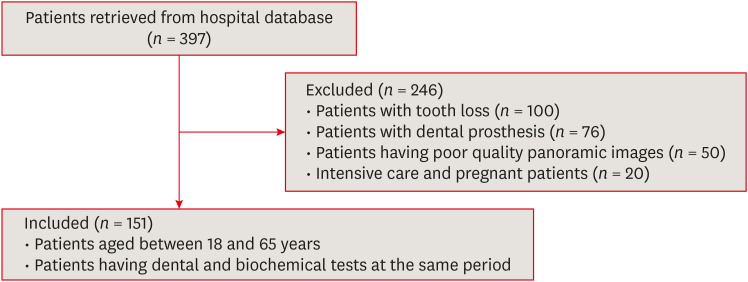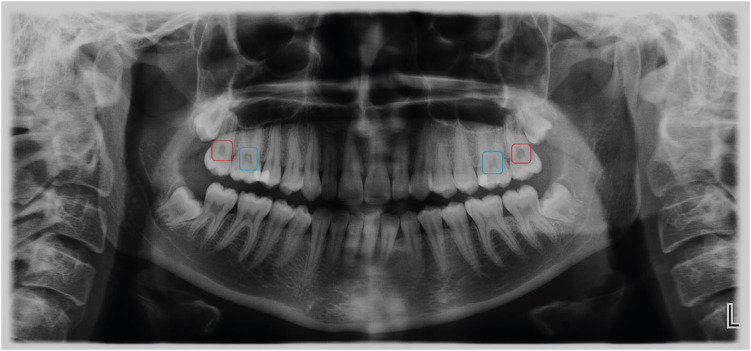Restor Dent Endod.
2024 May;49(2):e17. 10.5395/rde.2024.49.e17.
Pulp stones: any relevance with the levels of serum calcium, parathyroid hormone, vitamin D and uric acid
- Affiliations
-
- 1Department of Oral and Maxillofacial Radiology, Faculty of Dentistry, Muğla Sıtkı Koçman University, Muğla, Turkey
- 2Department of Medical Biochemistry, Faculty of Medicine, Muğla Sıtkı Koçman University, Muğla, Turkey
- KMID: 2556546
- DOI: http://doi.org/10.5395/rde.2024.49.e17
Abstract
Objectives
This study evaluated the effect of serum calcium, parathyroid hormone (PTH), vitamin D, and uric acid levels on pulp stone formation.
Materials and Methods
Patients who were admitted to the Muğla Sıtkı Koçman University, Faculty of Dentistry, Department of Oral and Maxillofacial Radiology for dental complaints were registered. Among these patients, individuals who had routine biochemical tests at the same period in the Outpatient Clinics of Muğla Sıtkı Koçman University Training and Research Hospital were included in the study. The patients with at least 1 pulp stone on panoramic radiographs recorded as the “pulp stone group” while patients without any pulp stones were the “control group”. Demographic data and serum levels of calcium, PTH, vitamin D, and uric acid were retrospectively evaluated in both groups. Student t-test or Mann-Whitney U test was used to evaluate the differences between the groups.
Results
Among 151 patients, dental pulp stone was detected in 53.6% of patients, and 82.7% of these patients were female. Female sex and pulp stone formation were significantly associated (p = 0.001). The mean age of the pulp stone group was 43.9, while it was 39.9 in the control group, without any significant correlation between age and pulp stone (p > 0.05). Similarly, there were no significant differences in serum levels of PTH, vitamin D, uric acid and calcium between groups (p > 0.05).
Conclusions
According to the present study, the effect of dental factors rather than systemic factors should be considered primarily in pulp stone formation.
Keyword
Figure
Reference
-
1. Jain P, Patni P, Hiremath H, Jain N. Successful removal of a 16 mm long pulp stone using ultrasonic tips from maxillary left first molar and its endodontic management. J Conserv Dent. 2014; 17:92–95. PMID: 24554871.2. Kannan S, Kannepady SK, Muthu K, Jeevan MB, Thapasum A. Radiographic assessment of the prevalence of pulp stones in Malaysians. J Endod. 2015; 41:333–337. PMID: 25476972.3. Ashutosh H, Pragya H, Divya KJ, Ramniwas K, Sharad P, Mansoor S. Correlation between pulp stones and serum calcium levels: a preliminary study. Int J Health Clin Res. 2021; 4:145–147.4. Patil S, Sinha N. Pulp stone, haemodialysis, end-stage renal disease, carotid atherosclerosis. J Clin Diagn Res. 2013; 7:1228–1231. PMID: 23905147.5. Gunen Yilmaz S, Yilmaz F, Bayrakdar IS, Harorli A. The relationship between carotid artery calcification and pulp stone among hemodialysis patients: a retrospective study. Saudi J Kidney Dis Transpl. 2019; 30:755–763. PMID: 31464230.6. Goga R, Chandler NP, Oginni AO. Pulp stones: a review. Int Endod J. 2008; 41:457–468. PMID: 18422587.7. Ertas ET, Veli I, Akin M, Ertas H, Atici MY. Dental pulp stone formation during orthodontic treatment: a retrospective clinical follow-up study. Niger J Clin Pract. 2017; 20:37–42. PMID: 27958244.8. S N, Chandran A, B S, S G, A M, Muddebihal F, et al. Pulp stones: diagnostic significance in early diagnosis and radiographic correlation with ischemic heart diseases. Indian J Radiol Imaging. 2021; 31:277–283. PMID: 34556908.9. Patil SR. Prevalence of and relationship between pulp and renal stones: a radiographic study. J Oral Biol Craniofac Res. 2015; 5:189–192. PMID: 26605145.10. Gabardo MCL, Wambier LM, Rocha JS, Küchler EC, de Lara RM, Leonardi DP, et al. Association between pulp stones and kidney stones: a systematic review and meta-analysis. J Endod. 2019; 45:1099–1105.e2. PMID: 31351581.11. Gabardo MCL, Kublitski PMO, Sette IR, Lauschner T, Juglair MM, Baratto-Filho F, et al. Sialometric and sialochemical analysis in individuals with pulp stones. Front Cell Dev Biol. 2020; 8:403. PMID: 32596238.12. Turkal M, Tan E, Uzgur R, Hamidi M, Colak H, Uzgur Z. Incidence and distribution of pulp stones found in radiographic dental examination of adult Turkish dental patients. Ann Med Health Sci Res. 2013; 3:572–576. PMID: 24380011.13. Ivanauskaitė D, Kubiliūtė D, Janavičienė D, Brukienė V. Prevalence of pulp stones in molars based on bitewing and periapical radiographs. Stomatologija. 2021; 23:9–15. PMID: 34528902.14. Gulsahi A, Cebeci AI, Ozden S. A radiographic assessment of the prevalence of pulp stones in a group of Turkish dental patients. Int Endod J. 2009; 42:735–739. PMID: 19549152.15. Sisman Y, Aktan AM, Tarim-Ertas E, Ciftçi ME, Sekerci AE. The prevalence of pulp stones in a Turkish population. A radiographic survey. Med Oral Patol Oral Cir Bucal. 2012; 17:e212–e217. PMID: 22143688.16. Ravanshad S, Khayat S, Freidonpour N. The prevalence of pulp stones in adult patients of Shiraz dental school, a radiographic assessment. J Dent (Shiraz). 2015; 16:356–361. PMID: 26636125.17. Jannati R, Afshari M, Moosazadeh M, Allahgholipour SZ, Eidy M, Hajihoseini M. Prevalence of pulp stones: a systematic review and meta-analysis. J Evid Based Med. 2019; 12:133–139. PMID: 30461204.18. Ranjitkar S, Taylor JA, Townsend GC. A radiographic assessment of the prevalence of pulp stones in Australians. Aust Dent J. 2002; 47:36–40. PMID: 12035956.19. Ravichandran S, Vadivel JK. Prevalence of pulp stones in IOPA radiographs. J Adv Pharm Technol Res. 2022; 13:S63–S66. PMID: 36643118.20. Hsieh CY, Wu YC, Su CC, Chung MP, Huang RY, Ting PY, et al. The prevalence and distribution of radiopaque, calcified pulp stones: a cone-beam computed tomography study in a northern Taiwanese population. J Dent Sci. 2018; 13:138–144. PMID: 30895109.21. Babu SJ, Swarnalatha C, Rao AP, Kumar BB, Tilak BP, Naidu RB, et al. Pulp stones as risk predictors for coronary artery disease. Int J Prev Med. 2020; 11:7. PMID: 32089807.22. Aleksova P, Serafimoski V, Popovska M, Ristovski M. Pulp stones can help in detection of calculus in the kidneys and/or in the bile--fact or fiction? Pril (Makedon Akad Nauk Umet Odd Med Nauki). 2013; 34:159–167. PMID: 24280890.23. Tarim Ertas E, Inci M, Demirtas A, Ertas H, Yengil E, Sisman Y, et al. A radiographic correlation between renal and pulp stones. West Indian Med J. 2014; 63:620–625. PMID: 25803378.24. Galav A, Vyas T, Kaur M, Chauhan M, Satija N, et al. Association of pulp stones & renal stones- a clinical study. Int J Res Health Allied Sci. 2018; 4:82–84.25. Kumar T, Puri G, Aravinda K, Laller S, Jatti D, Gupta R. Correlation between prevalence of pulp stones and renal stones in Panchkula region of India. SRM J Res Dent Sci. 2015; 6:150–154.26. Movahhedian N, Haghnegahdar A, Owji F. How the prevalence of pulp stone in a population predicts the risk for kidney stone. Iran Endod J. 2018; 13:246–250. PMID: 29707023.27. Moudi E, Kazemi A, Madani Z, Haghanifar S, Moudi E. A radiographic correlation between the presence of pulp stones and kidney stones. Casp J Appl Sci Res. 2015; 4:1–7.28. Jawahar G, Rao GN, Vennila AA, Fathima SD, Lawanya MKK, Doss DM, et al. Clinicopathological correlation of pulp stones and its association with hypertension and hyperlipidemia: an hospital-based prevalence study. J Pharm Bioallied Sci. 2021; 13:S1268–S1274. PMID: 35017969.29. Yeluri G, Kumar CA, Raghav N. Correlation of dental pulp stones, carotid artery and renal calcifications using digital panoramic radiography and ultrasonography. Contemp Clin Dent. 2015; 6:S147–S151. PMID: 26604565.30. Kansu O, Ozbek M, Avcu N, Aslan U, Kansu H, Gençtoy G. Can dental pulp calcification serve as a diagnostic marker for carotid artery calcification in patients with renal diseases? Dentomaxillofac Radiol. 2009; 38:542–545. PMID: 20026712.31. Auron A, Alon US. Hypercalcemia: a consultant’s approach. Pediatr Nephrol. 2018; 33:1475–1488. PMID: 28879535.32. Botelho J, Machado V, Proença L, Delgado AS, Mendes JJ. Vitamin D deficiency and oral health: a comprehensive review. Nutrients. 2020; 12:1471. PMID: 32438644.33. Uwitonze AM, Rahman S, Ojeh N, Grant WB, Kaur H, Haq A, et al. Oral manifestations of magnesium and vitamin D inadequacy. J Steroid Biochem Mol Biol. 2020; 200:105636. PMID: 32084549.34. Giunta JL. Dental changes in hypervitaminosis D. Oral Surg Oral Med Oral Pathol Oral Radiol Endod. 1998; 85:410–413. PMID: 9574950.
- Full Text Links
- Actions
-
Cited
- CITED
-
- Close
- Share
- Similar articles
-
- Hypoparathyroidism: Replacement Therapy with Parathyroid Hormone
- Biochemical Characteristics of Serum and Urine in the Patients with Uric Acid Stone
- Study on Serum and Urinary Levels of Calcium, Inorganic Phosphorus and Uric Acid in Patients with Urinary Stone and Immobilized State
- Increase in the Serum Parathyroid Hormone Level During a Bisphosphonate Drug Holiday
- Primary Hyperparathyroidism in a Child with Urolithiasis: 1 Case



